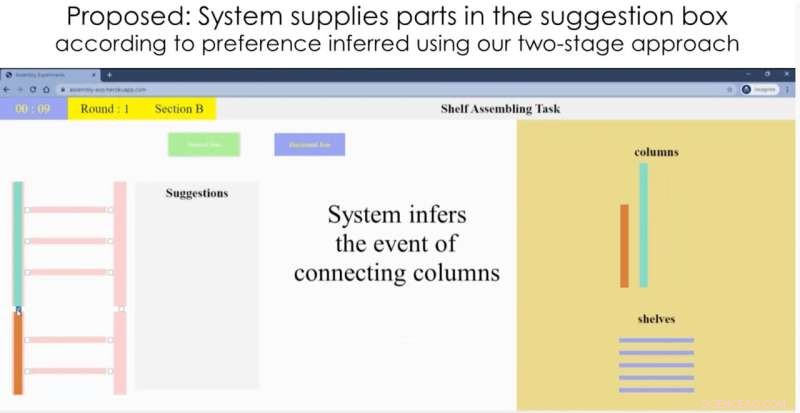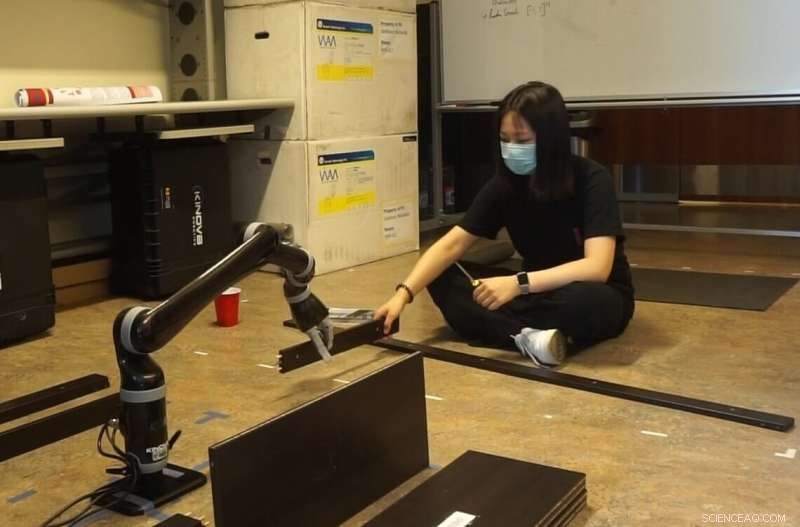
Un juego en línea de ensamblaje de estantes, desarrollado como prueba de concepto. Crédito:Universidad del Sur de California
A medida que los robots se unen cada vez más para trabajar con humanos, desde hogares de ancianos hasta almacenes y fábricas, deben poder ofrecer apoyo de manera proactiva. Pero primero, los robots tienen que aprender algo que sabemos instintivamente:cómo anticiparse a las necesidades de las personas.
Con ese objetivo en mente, los investigadores de la Escuela de Ingeniería Viterbi de la USC han creado un nuevo sistema robótico que predice con precisión cómo un humano construirá una librería IKEA y luego echa una mano, proporcionando el estante, el perno o el tornillo necesarios para completar la tarea. . La investigación se presentó en la Conferencia Internacional sobre Robótica y Automatización el 30 de mayo de 2021.
"Queremos que el humano y el robot trabajen juntos:un robot puede ayudarlo a hacer las cosas más rápido y mejor al realizar tareas de apoyo, como buscar cosas", dijo el autor principal del estudio, Heramb Nemlekar. "Los humanos aún realizarán las acciones principales, pero pueden descargar acciones secundarias más simples al robot".
Nemlekar, un doctorado. estudiante de ciencias de la computación, está supervisado por Stefanos Nikolaidis, profesor asistente de ciencias de la computación, y es coautor del artículo con Nikolaidis y SK Gupta, profesor de ingeniería aeroespacial, mecánica e informática que ocupa la Cátedra Internacional Smith en Ingeniería Mecánica.
Adaptarse a las variaciones
En 2018, un robot creado por investigadores en Singapur aprendió a ensamblar una silla IKEA. En este nuevo estudio, el equipo de investigación de la USC tiene como objetivo centrarse en la colaboración entre humanos y robots.
Hay ventajas en combinar la inteligencia humana y la fuerza de un robot. En una fábrica, por ejemplo, un operador humano puede controlar y monitorear la producción, mientras que el robot realiza el trabajo físicamente extenuante. Los humanos también son más hábiles en esas tareas delicadas y complicadas, como mover un tornillo para que encaje.
The key challenge to overcome:humans tend to perform actions in different orders. For instance, imagine you're building a bookcase—do you tackle the easy tasks first, or go straight for the difficult ones? How does the robot helper quickly adapt to variations in its human partners?
"Humans can verbally tell the robot what they need, but that's not efficient," said Nikolaidis. "We want the robot to be able to infer what the human wants, based on some prior knowledge."
It turns out, robots can gather knowledge much like we do as humans:by "watching" people, and seeing how they behave. While we all tackle tasks in different ways, people tend to cluster around a handful of dominant preferences. If the robot can learn these preferences, it has a head start on predicting what you might do next.
A good collaborator
Based on this knowledge, the team developed an algorithm that uses artificial intelligence to classify people into dominant "preference groups," or types, based on their actions. The robot was fed a kind of "manual" on humans:data gathered from an annotated video of 20 people assembling the bookcase. The researchers found people fell into four dominant preference groups.

In an IKEA furniture assembly task, a human stayed in a “work area” and performed the assembling actions, while the robot brought the required materials from storage area. Credit:University of Southern California
For instance, do you connect all the shelves to the frame on just one side first; or do you connect each shelf to the frame on both sides, before moving onto the next shelf? Depending on your preference category, the robot should bring you a new shelf, or a new set of screws. In a real-life IKEA furniture assembly task, a human stayed in a "work area" and assembled the bookcase, while the robot—a Kinova Gen 2 robot arm—learned the human's preferences, and brought the required materials from a storage area.
"The system very quickly associates a new user with a preference, with only a few actions," said Nemlekar.
"That's what we do as humans. If I want to work to work with you, I'm not going to start from zero. I'll watch what you do, and then infer from that what you might do next."
In this initial version, the researchers entered each action into the robotic system manually, but future iterations could learn by "watching" the human partner using computer vision. The team is also working on a new test-case:humans and robots working together to build—and then fly—a model airplane, a task requiring close attention to detail.
Refining the system is a step towards having "intuitive" helper robots in our daily lives, said Nikolaidis. Although the focus is currently on collaborative manufacturing, the same insights could be used to help people with disabilities, with applications including robot-assisted eating or meal prep.
"If we will soon have robots in our homes, in our work, in care facilities, it's important for robots to infer and adapt to people's preferences," said Nikolaidis. "The robot needs to be a teammate and a good collaborator. I think having some notion of user preference and being able to learn variability is what will make robots more accepted."